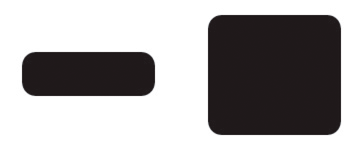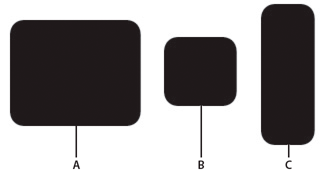Normally when a display object is scaled
(for example, stretched horizontally), the resulting distortion
is spread equally across the object, so that each part is stretched
the same amount. For graphics and design elements, this is probably what
you want. However, sometimes it’s preferable to have control over
which portions of the display object stretch and which portions
remain unchanged. One common example of this is a button that’s
a rectangle with rounded corners. With normal scaling, the corners
of the button will stretch, making the corner radius change as the
button resizes.
However, in this case it would be preferable to have control
over the scaling—to be able to designate certain areas which should
scale (the straight sides and middle) and areas which shouldn’t
(the corners)—so that scaling happens without visible distortion.

You can use 9-slice scaling (Scale-9) to create display objects
where you have control over how the objects scale. With 9-slice
scaling, the display object is divided into nine separate rectangles
(a 3 by 3 grid, like the grid of a tic-tac-toe board). The rectangles
aren’t necessarily the same size—you designate where the grid lines
are placed. Any content that lies in the four corner rectangles
(such as the rounded corners of a button) will not be stretched
or compressed when the display object scales. The top-center and
bottom-center rectangles will scale horizontally but not vertically,
while the left-middle and right-middle rectangles will scale vertically
but not horizontally. The center rectangle will scale both horizontally
and vertically.

Keeping this in mind, if you’re creating a display object and
you want certain content to never scale, you just have to make sure
that the dividing lines of the 9-slice scaling grid are placed so
that the content ends up in one of the corner rectangles.
In ActionScript, setting a value for the
scale9Grid
property
of a display object turns on 9-slice scaling for the object and
defines the size of the rectangles in the object’s Scale-9 grid.
You use an instance of the Rectangle class as the value for the
scale9Grid
property,
as follows:
myButton.scale9Grid = new Rectangle(32, 27, 71, 64);
The four parameters of the Rectangle constructor are the x coordinate,
y coordinate, width, and height. In this example, the rectangle’s
top-left corner is placed at the point x: 32, y: 27 on the display
object named
myButton
. The rectangle is 71 pixels
wide and 64 pixels tall (so its right edge is at the x coordinate
103 on the display object and its bottom edge is at the y coordinate 92
on the display object).
The actual area contained in the region defined by the Rectangle
instance represents the center rectangle of the Scale-9 grid. The
other rectangles are calculated by Flash Player and AIR by extending
the sides of the Rectangle instance, as shown here:
In this case, as the button scales up or down, the rounded corners
will not stretch or compress, but the other areas will adjust to
accommodate the scaling.

-
A.
-
myButton.width = 131;myButton.height = 106;
-
B.
-
myButton.width = 73;myButton.height = 69;
-
C.
-
myButton.width = 54;myButton.height = 141;
